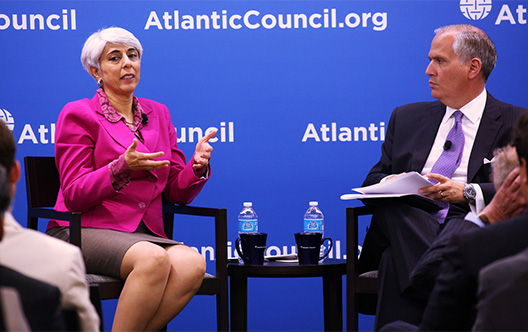 No discussion on disruptive technologies would be complete without the Defense Advanced Research Projects Agency (DARPA), which has been the leading developer of disruptive technologies for decades. Their work has brought us the internet, global positioning system, and that voice on your iPhone. Joining the Disruptive Defense conference for an afternoon keynote on Betting on Breakthrough Defense Technologies, Dr. Arati Prabhakar, director of DARPA, shared some of the exciting work being done by DARPA in an environment of decreasing budgets and military drawdown in Iraq and Afghanistan.
No discussion on disruptive technologies would be complete without the Defense Advanced Research Projects Agency (DARPA), which has been the leading developer of disruptive technologies for decades. Their work has brought us the internet, global positioning system, and that voice on your iPhone. Joining the Disruptive Defense conference for an afternoon keynote on Betting on Breakthrough Defense Technologies, Dr. Arati Prabhakar, director of DARPA, shared some of the exciting work being done by DARPA in an environment of decreasing budgets and military drawdown in Iraq and Afghanistan.
DARPA was created following the revelation of the Soviet Sputnik program and the need to rapidly exploit technology. Since then, as Dr. Prabhakar noted, DARPA has produced some of their own surprises: “Every time a radar is evaded, a soldier knows his precise position or a missile launch is detected we have succeeded,” she said in reference to the programs and technology that has enabled military equipment for decades.
Dr. Prahhakar addressed three particular areas of research that she believes have great promise. The first area, while not a specific technology, confronts the current military technology paradigm of costly and inflexible military systems. A result of cutting edge technologies with complex sub systems is the need for those subsystems to be tightly integrated. In the past, this has meant that, as a new system is developed, a massive platform was created to squeeze as much technology onto it as possible. This method is costly and hostile to upgrades because of that tightly-coupled subsystem connectivity. As the size and cost of computer processing decreases, the system architecture can be distributed to make it more flexible, less costly, and hospitable to changes and advances. This is an important project, Dr. Prahhakar said, because the days of using “our deep pockets as an advantage on the battlefield are over.”
The second area of research is in the field of information technology. As earlier panels in the day highlighted, dealing with the absence of data can be difficult, but corrupt data is a much greater challenge. DARPA is working on several information technology efforts that will help the user to trust his data and to deal with the tremendous volume of data that is relevant to numerous aspects of providing national security and warfighting. However, Dr. Prabhakar cautioned, “new solutions will make our data more secure but not invulnerable.” DARPA also hopes to tackle an even greater challenge than securing our data – providing verification of its authenticity – to prevent a photograph’s misuse as propaganda, for example.
The third area she highlighted was what she called areas of “technological surprise” where biology and engineering find synergy, for example. Until recently, biology was a field where scientists were still learning and discovering. Now, the field provides practical solutions to problems such as containing the spread of disease, development of synthetic biology and advancing brain function.
Dr. Prabhakar finished her prepared remarks by recognizing a theme from today’s conference: the most disruptive technologies are now accessible by a much wider population. However, she said, “while we cannot count on the US monopoly of technology, if we can learn to apply it better and faster, we will still lead the way.” To that end, DARPA remains a small, diverse but agile force of program managers and technical experts supporting the warfighter.
Image: Arati Prabhakar, Director, Defense Advanced Research Projects Agency, US Department of Defense speaks with Vago Muradian, Editor, Defense News
